Enhancing Bathroom Mirrors with Proper Lighting
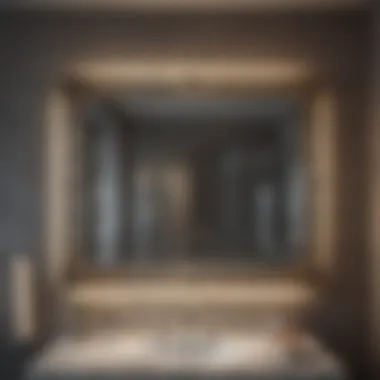
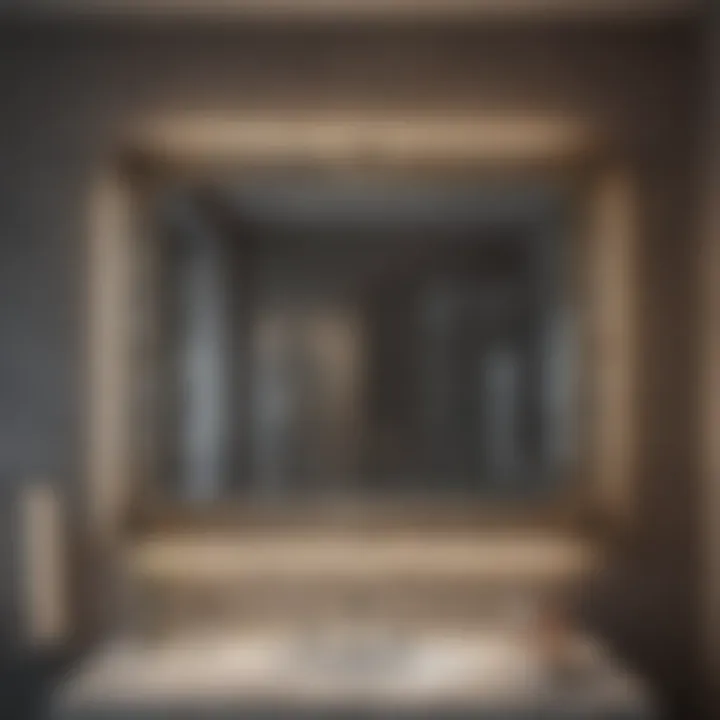
Intro
Bathroom lighting above mirrors isn't just about functionality; it's a blend of form and function that can enhance the overall experience of this often-overlooked space. When considering how to create a pleasant environment, the placement and style of lighting play a vital role. A well-lit mirror can make all the difference in the morning, whether you're applying makeup, shaving, or simply getting ready for the day. In this article, we'll traverse the nuances of bathroom lighting, exploring trending styles, color palettes, and some practical tips to help readers elevate their bathroom spaces for both utility and tranquility.
Trending Styles
Modern Minimalism
In the world of contemporary design, modern minimalism reigns supreme. Clean lines and understated elegance characterize this style, and lighting fixtures that embody these principles work exceptionally well above bathroom mirrors. Consider sleek, geometric shapes or unobtrusive light bars that provide even illumination without overwhelming the senses. A simple, unobtrusive fixture can maintain the room's airy feel while delivering the needed light for daily grooming.
Some examples of modern minimalist fixtures include:
- LED strip lights that can be installed directly above or around mirrors,
- Slim pendant lights that add a touch of flair without dominating the space,
- Recessed lighting that blends seamlessly into the ceiling, providing ambient illumination without taking away from the elegance of the design.
Cozy Rustic
For those who lean towards a cozier atmosphere, rustic lighting installations can transform a sterile bathroom into a warm retreat. Earthy tones, natural materials, and vintage-inspired fixtures highlight this aesthetic. Think wrought iron sconces or wooden-framed mirror lights that evoke a sense of comfort and simplicity. Rustic lighting above mirrors can amplify the charm of a farmhouse-style bathroom or any space that embraces nature-inspired design.
Incorporate these rustic ideas:
- Lantern-style sconces that add an inviting glow,
- Weathered wood accents to frame mirrors, conjuring the feel of a cozy cabin,
- Edison bulb fixtures for a touch of vintage appeal.
Color Palettes
Calming Neutrals
The color palette of a bathroom can dramatically affect its mood. Calming neutrals like soft whites, warm beiges, or gentle grays create a serene backdrop and allow light to reflect beautifully. When pairing neutral hues with lighting above mirrors, consider fixtures in similar tones to promote a cohesive look. For instance, a brushed nickel light fixture can complement a light gray bathroom, enhancing the soothing atmosphere.
Using calming neutrals:
- Soft lighting helps create a spa-like ambiance that makes daily rituals feel more relaxing,
- Mirrors with proper lighting can reflect natural light, making the space feel larger and more open,
- The uniform color palette aids in the flow between adjoining rooms, creating a cohesive residential feel.
Bold Accents
On the other end of the spectrum, bold accents can foster a lively and energetic bathroom environment. Opting for vibrant or dark hues as a backdrop allows luminous fixtures to really pop. Imagine a deep navy wall with gold or brass fixtures illuminating a sleek mirror; the interplay of these elements can make a statement. Such setups often set the tone for each visit to the bathroom, whether for a quick refresh or an indulgent soak.
Key elements to consider:
- Contrasting colors enhance the effectiveness of bathroom lighting while providing a sense of drama,
- Use colored light bulbs or smart lighting options to change the mood,
- A strong juxtaposition between lighting and wall color can become a conversation piece, transforming your bathroom into a chic sanctuary.
"Lighting is not just an afterthought; it shapes how we experience our space."
Preamble to Bathroom Lighting
When you think about your bathroom, what comes to mind? Is it just a spot for daily routines, or does it hold deeper significance within your home? Bathroom lighting, particularly the lighting that’s placed above mirrors, plays a crucial role in enhancing both functionality and aesthetics in this often overlooked space.
Importance of Adequate Lighting
Bright, well-placed lighting is more than just a convenience; it’s essential for the overall usability of the bathroom.
- Practicality: Properly illuminated mirrors make tasks like shaving or applying makeup significantly easier. Without adequate lighting, a person’s effort can be wasted, leading to mishaps that could have been avoided. Dim or poorly positioned lights can make a well-planned routine feel like a game of chance.
- Visibility: Whether you’re getting ready for work or prepping for a night out, adequate light ensures that every detail is clear. You want to avoid surprises, like discovering an unshaved patch or uneven makeup application at the last moment.
- Safety: Good lighting reduces accidents, particularly in a space that often has wet surfaces. Think about it: slipping in the bathroom is a real concern, and clear visibility can minimize that risk.
In essence, adequate lighting above mirrors sets the stage for a functional environment that can make or break your day.
Influence on Mood and Atmosphere
Bathroom lighting casts more than just light; it can shape the atmosphere and mood of the space. Have you ever stepped into a softly-lit bathroom and felt instantly relaxed?
- Creating Calm: Thoughtfully designed lighting can transform your morning routine. Warm lights emit a cozy feel, healing the remnants of sleep while gently coaxing you into the day. They create an inviting space for a long soak in the tub at the end of a tiring day.
- Setting Tone: Bright, white lights can invigorate you, making it easier to start the day with energy. Conversely, dimmer lights can foster a relaxing atmosphere for winding down in the evening. The ability to alter the lighting can impact how you feel, enhancing relaxation or boosting motivation as needed.
Understanding Lighting Above Mirrors
Bathroom lighting designed specifically for placement above mirrors is not just an afterthought; it’s a crucial component that can define the functionality and ambience of the space. The right lighting above mirrors serves to enhance visibility during personal grooming rituals, ensures accurate color rendering for makeup application, and creates an inviting atmosphere that can turn an ordinary bathroom into a relaxing sanctuary.
Functionality and Purpose
One of the primary functions of lighting above mirrors is to provide adequate illumination for daily activities. Imagine waking up on a chilly morning, reaching for the bathroom light switch, but struggling to see your own reflection clearly. This scenario is far too common and illustrates the importance of proper lighting above mirrors. Bright, evenly distributed light can help reduce shadows on the face, which is essential for tasks such as shaving or applying skincare products. No one wants to head out the door with uneven foundation or an unruly beard due to poor lighting.
Moreover, good lighting can significantly increase the sense of space within the bathroom. For instance, the reflective nature of mirrors combined with well-placed lights can make an average-sized bathroom feel more expansive. It’s not merely about throwing in a bright bulb; it’s about strategically positioning lights to enhance both form and function.
Aesthetic Value of Strategic Placement
Beyond functionality, the aesthetic value of lighting above mirrors should not be overlooked. Consider the difference in atmosphere when the lights are strategically placed compared to random placement. A beautifully designed fixture not only illuminates your reflection but also acts as a visual anchor in your bathroom decor. The interplay of light and shadow created by a well-positioned lighting fixture can define the mood, from warm and inviting to crisp and modern.
Using a combination of different fixture types can add depth to the design theme. Wall-mounted sconces, for instance, can provide a soft glow beside the mirror, while a striking vanity light across the top offers direct illumination. Collaboratively, these elements contribute to a cohesive aesthetic.
"A proper balance of light enhances not only functionality but also the overall elegance of the bathroom."
In summary, understanding the role of lighting above mirrors encompasses both its practical aspect—helping with daily routines—and its aesthetic contribution to bathroom design. Making informed choices about lighting fixtures and placements can transform a mundane bathroom into a tailored personal retreat.
Types of Lighting Fixtures
When it comes to lighting above mirrors, the type of fixtures you choose can significantly influence both aesthetics and functionality in the bathroom. Different lighting structures provide various benefits and visual effects. This section will explore four primary types of lighting fixtures: wall-mounted sconces, vanity lights, recessed lighting, and LED strip lighting. By understanding the nuances of each, homeowners can make informed choices that enhance their personal space.
Wall-Mounted Sconces
Wall-mounted sconces bring a touch of elegance to the bathroom while providing directed illumination. These fixtures are typically mounted on either side of a mirror, helping to eliminate shadows on the face, which is particularly crucial during grooming activities.
- Benefits:
- Considerations:
- They offer flexibility in height adjustment, catering to different user heights.
- The design options range widely, allowing for personalized decor that complements the overall theme of the bathroom.
- Proper placement is vital: too high or low can result in inadequate lighting.
- Ensure that the sconces are moisture-resistant to prevent any damage over time.
Vanity Lights
Vanity lights are a classic choice for illuminating a bathroom mirror. Mounted directly above or on either side of the mirror, they provide a bright, even light essential for tasks such as makeup application or shaving.
- Benefits:
- Considerations:
- These fixtures can come in multiple styles, from industrial to vintage, allowing you to align your lighting with your home’s aesthetic.
- They often use bulbs that offer a higher lumen output, which translates to brighter light, perfect for detailed tasks.
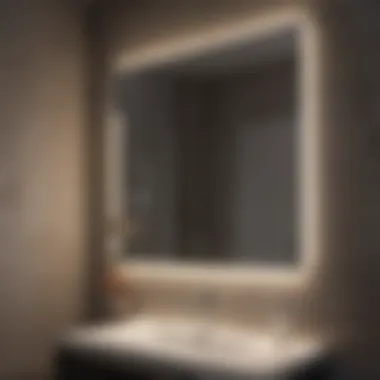
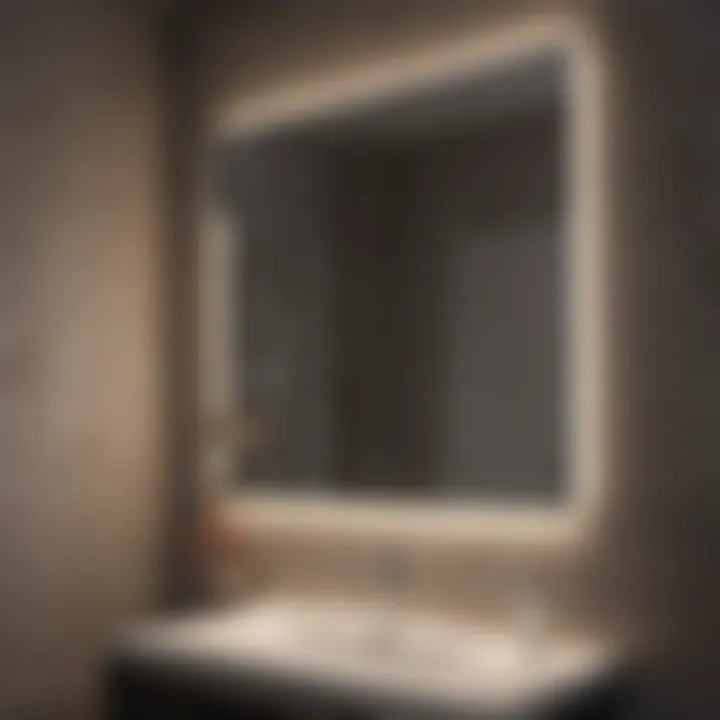
- Ensure the wattage is appropriate for the size of your bathroom; overly bright lights might cause glare.
- Pay attention to the bulb's color temperature—something too warm may not be practical for grooming tasks.
Recessed Lighting
Recessed lighting, often referred to as can lights or pot lights, provides a sleek, modern look while offering wide coverage. Installed in the ceiling, they can illuminate the entire space, including the mirror area, without taking away from the design.
- Benefits:
- Considerations:
- Offers a clean appearance by being flush with the ceiling, contributing to an uncluttered aesthetic.
- Adjustable fixtures can direct light towards the mirror, optimizing reflection without creating shadows.
- Placement requires careful planning to ensure proper illumination; too few may leave areas dim.
- Compatibility with dimmer switches can enhance functionality, allowing users to adjust light levels according to time of day or mood.
LED Strip Lighting
LED strip lighting has become increasingly popular due to its versatility and modern feel. These flexible strips can be installed along the edges of mirrors or above them, providing ambient or task lighting as needed.
- Benefits:
- Considerations:
- They consume less energy than traditional bulbs, contributing to lower utility bills.
- Available in a variety of colors and brightness levels, LED strips allow for customization of the lighting atmosphere.
- Ensure that the adhesive used for installation is strong enough to withstand bathroom humidity.
- It's important to choose high-quality strips that are rated for damp locations to avoid safety issues.
Overall, selecting the right lighting fixture involves analyzing the space's specific needs, the ambiance you want to create, and how each type of lighting contributes to daily activities and overall design. Whether it's adding a bit of flair with sconces or keeping it simple with recessed lighting, choices made today can transform routine tasks into something greater.
Choosing the Right Bulb
Selecting the right bulb for bathroom lighting above mirrors is essential in achieving a balance between functionality and ambiance. Proper bulb choice plays a pivotal role not just in how well you can see while preparing for your day, but also in how this light influences the overall atmosphere. Imagine standing in front of a mirror, applying makeup or grooming. If the light isn't just right, it can lead to a less than flattering reflection that can throw off your day.
When considering bulbs, two key aspects come into play: temperature and color casting, as well as brightness levels and wattage. Both elements can significantly affect how effective your mirror lighting will be, impacting both utility and mood.
Temperature and Color Casting
The temperature of light, measured in Kelvin, determines the color tone of the illumination. A lower Kelvin number represents a warmer, more yellow glow, while a higher number indicates a cooler, bluish light. This temperature can set the mood for your bathroom. For instance, if you prefer a more inviting and cozy space, bulbs around 2700K to 3000K are typically ideal.
On the other hand, if you lean towards a more refined atmosphere that mimics daylight, you might opt for bulbs rated between 4000K and 5000K. Daylight-balanced bulbs are particularly advantageous for tasks requiring precision, such as applying makeup or shaving, as they allow you to see colors accurately and reduce the chances of unintended mishaps.
"The right temperature and color can transform your bathroom from a mere utility space to a personal sanctuary."
Brightness Levels and Wattage
When it comes to brightness, understanding wattage is key. Traditionally, higher wattage meant brighter light, but with modern LED technology, this notion has evolved. For typical bathroom lighting, aim for around 60-100 watts when using incandescent or halogen bulbs, while LED options generally require significantly less wattage to achieve the same luminance. Thus, the efficiency of LED bulbs can save more than just energy; they can also extend the lifespan of your fixtures.
Brightness levels should cater to the functionality of the bathroom. A well-lit mirror can be pivotal, particularly in the morning when the natural light is scarce. When choosing, prioritize bulbs that can emit at least 800 lumens to ensure you can see clearly without squinting or straining your eyes.
In summary, choosing the right bulb isn’t just about light; it’s about creating the perfect environment for you and your needs, balancing brightness, warmth, and effectiveness in every square inch of your bathroom.
Design Considerations for Lighting
When it comes to illuminating your bathroom, particularly above mirrors, design considerations play a pivotal role in creating a functional and aesthetically pleasing environment. The right lighting can enhance your daily routines, allowing you to see clearly while also setting the overall tone of the space. Balancing various elements—such as natural light sources, artificial lighting schemes, and the scale of fixtures—can transform a mundane bathroom experience into a personal oasis.
The importance of thoughtful design cannot be overstated. A well-lit mirror area is not just about visibility; it’s about how you interact with that space. Properly placed lighting above mirrors can augment your confidence during grooming tasks like shaving or applying makeup. Furthermore, a harmonious blend of light types can elevate the bathroom's overall vibe, making it an inviting retreat rather than merely a functional space.
Balancing Natural and Artificial Light
Finding a balance between natural and artificial light sources is crucial in bathroom design. Natural light can offer a warm glow during the day, enhancing the colors and textures of your space, while artificial lighting provides consistency when the sun goes down.
If your bathroom has a window, consider positioning mirrors to maximize sunlight. A mirror strategically placed across a window can reflect natural light throughout the room, creating a bright and airy ambience. Using sheer window treatments allows for ample light without sacrificing privacy.
In addition to windows, layering your artificial lighting can help compensate in low-light environments. Combining overhead lights such as recessed lighting with wall-mounted sconces can provide a comprehensive solution. Choosing bulbs with the right color temperature—typically around 3000K to 4000K—will also ensure that your skin tones appear true-to-life.
Proportion and Scale in Space
Proportion and scale are significant factors in bathroom lighting design. The size of your fixtures should correlate with the size of your mirrors, countertops, and overall space. A large vanity mirror surrounded by oversized fixtures can seem out of place, creating a jarring visual. Similarly, petite fixtures on a grand mirror can feel overwhelmed by their surroundings.
Consider these points when determining the right scale:
- Fixture Size: Choose lighting fixtures that complement the size of the mirror. For instance, larger mirrors often benefit from two or more multi-light sconces or a wide vanity light.
- Height of Fixtures: Position fixtures at an ideal height. As a general guideline, place fixtures 60 to 70 inches from the floor; this ensures adequate lighting for most users.
- Visual Weight: Balance the visual weight of your lighting in conjunction with other elements, such as toilets, cabinets, and bathtubs. This helps achieve a cohesive look throughout the room.
"An effective design honors the bathroom space, enhancing its functionality while complementing personal style."
In summary, aligning design considerations, such as balancing natural and artificial light and respecting proportion and scale, sets the stage for effective bathroom lighting. Attention to these elements ensures that the space works in harmony with your daily habits and style preferences. This thoughtful approach to lighting will not only enhance your practical daily routines but also contribute to a serene atmosphere.
Installation Techniques
When it comes to bathroom lighting above mirrors, how you go about the installation is just as crucial as the type of fixtures you choose. Not only does correct installation improve the utility of the lighting, but it also elevates the overall design of your bathroom. You might think of it as the icing on the cake; the right lighting makes everything pop, creating an inviting and functional space.
Placement Height Recommendations
Finding the right placement height for your lighting is akin to ensuring a picture hangs just right on the wall. Too high, and you lose the effectiveness; too low, and it might cast unflattering shadows. A general guideline for most mirror lighting fixtures is to position them about 66 to 70 inches above the floor. This height works well for average-sized individuals and allows for even illumination across the face. However, you should consider the height of the mirror and the users.
A couple of points to bear in mind:
- If the lighting is too far above the mirror, it can create shadows under your chin or nose.
- For taller individuals, you might want to adjust accordingly. Remember, the idea is to ensure light shines down for even reflection without distortions.
You could always step back and take a look. Imagine sneaking a peek as if you were applying foundation or shaving—does the light swirl around without causing any undue highlights or shadows?
Wiring and Electrical Considerations
Let’s shift gears to the slightly more technical aspect—wiring and electrical considerations. Proper wiring is crucial, not just for functionality, but for safety.
Common Mistakes and Solutions
Bathroom lighting is not just functional; it sets the whole tone for the space. A well-thought-out lighting scheme can transform a mundane bathroom into a serene retreat. However, there are common pitfalls that many homeowners fall into that hinder their efforts to create the optimal environment. Understanding these mistakes and their solutions is paramount for achieving effective mirror lighting above the sink.
Overly Harsh Lighting
One of the most prevalent issues in bathroom lighting is the use of overly harsh lighting, which can turn a spa-like haven into a stark interrogation room in a matter of seconds. This type of lighting can be particularly unflattering. Imagine stepping up to the mirror only to be greeted by a bright glare that highlights every imperfection. Not only does it ruin your mood, but it can also affect your self-esteem as you prep for your day.
To mitigate the harshness, consider the following strategies:
- Opt for Dimmer Switches: Installing a dimmer switch provides control over the light intensity, allowing you to adjust the ambiance according to your needs, whether you’re getting ready for a busy day or unwinding after work.
- Use Multiple Light Sources: Instead of relying on one bright overhead fixture, a combination of sconces and ambient lighting can envelop the area without overwhelming it. This layered lighting approach softens the overall effect.
By employing smarter lighting techniques, you can create a harmonious balance that is both functional and soothing.
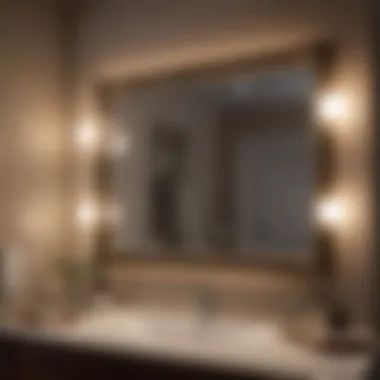
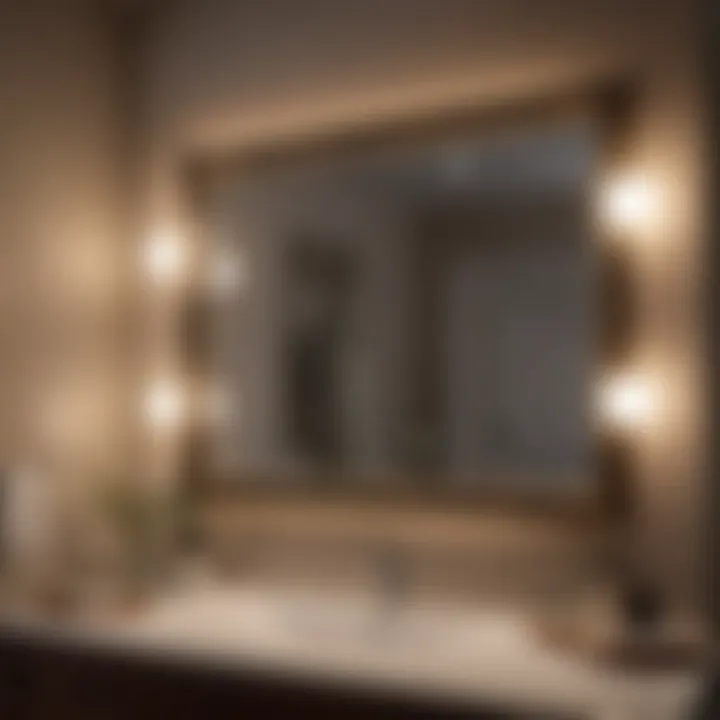
Poor Bulb Choices
Another common snag is making poor bulb choices—a mistake that echoes beyond aesthetics, affecting mood and utility. The variety of bulbs can be mind-boggling, which often leads homeowners to pick bulbs that may not be fully suitable for their space. For instance, using cool white LEDs might feel too clinical, while outdated incandescent bulbs may drain energy and don’t always provide the clarity needed for grooming tasks.
Here’s how to choose wisely:
- Consider Color Temperature: Aim for bulbs with a color temperature of around 2700K to 3000K. This warmer glow is more inviting, and it works wonders for enhancing skin tones when sitting in front of a mirror.
- Prioritize Energy Efficiency: Look for LED bulbs that are rated for wet or damp locations, especially if you’re placing them in areas where moisture is a concern. They last longer and significantly cut down on energy consumption—good for the planet and your wallet.
Incorporating these suggestions not only improves the lighting quality but also contributes to a more enjoyable bathroom experience.
"Good lighting is not just about visibility; it's about feelings and perceptions. Choose wisely, and your bathroom can feel like a luxury getaway rather than a mundane necessity."
Avoiding these common mistakes is essential in optimizing your bathroom’s lighting. Attention to detail can lead to solutions that elevate the entire experience, turning daily routines into enjoyable rituals.
Trends in Bathroom Lighting Design
In the realm of bathroom design, lighting above mirrors has become a focal point that combines both utility and artistry. The choices we make in this domain can significantly alter not just the aesthetics of the space but also the overall ambiance, affecting daily routines in ways we often overlook. Understanding these trends is crucial for those looking to enhance their bathrooms, making them more functional and inviting.
Minimalist Approaches
Minimalist bathroom lighting emphasizes simplicity and unencumbered design. This trend aligns perfectly for those who prefer clean lines and uncluttered spaces. Often embraced in modern homes, minimalist lighting focuses on essential elements that serve a purpose without overwhelming the visual appeal of the bathroom.
Key Characteristics:
- Sleek fixtures: Light bars or wall sconces with a streamlined silhouette.
- Neutral colors: White or soft tones that seamlessly blend with the bathroom's palette.
- Effective placement: Fixtures installed at eye level to ensure even light distribution without harsh shadows.
The beauty lies in the functionality; minimalism encourages one to select lighting that enhances clarity and visibility. Instead of ornate designs that compete for attention, these selections underscore an uncomplicated yet stylish approach.
"Less is more" is not just a saying but a guiding principle for many homeowners today.
Eclectic Styles
On the other end of the spectrum, eclectic styles bring a vibrant personality to bathroom lighting. This trend encourages mixing vintage finds with modern fixtures, allowing for a personalized expression of style. It’s an adventurous approach for those who relish the idea of crafting a unique space that reflects individual taste.
Characteristics of Eclectic Lighting:
- Diverse materials: Combining metal, glass, and ceramic for diverse textures.
- Playful designs: Unique shapes and colors that stand out, often used as statement pieces.
- Layered lighting: Incorporating different types of fixtures, such as chandeliers complemented by sconces or recessed lights.
A well-thought-out eclectic design can transform a mundane bathroom into a conversation starter. The interplay of various elements creates depth and interest, drawing the eye around the space and ensuring that no corner is left dull.
The Interplay of Lighting and Mirrors
Bathroom lighting, particularly above mirrors, plays a vital role in not only illuminating the space but also enhancing the overall experience. Mirrors serve as practical tools for self-grooming and personal care, but their effectiveness is significantly magnified with the right lighting. This section delves into the nuance of how lighting interacts with mirrors, highlighting its benefits, elements to consider, and how thoughtful placement can transform any bathroom.
"Good lighting is as fundamental as water—it nourishes the space and establishes presence."
Reflections and Amplification of Light
The relationship between lighting and mirrors is a dance of reflections. Hang elegant sconces beside your mirror, or choose an overhead fixture that casts downward. Such choices can double or even triple the perceived brightness of the room. When light hits a mirror, it amplifies the glowing ambiance, making a smaller space feel airier or creating a sense of luxury in a more expansive room.
Properly placed lights ensure no harsh shadows mess up one's grooming routine. Think about this: a soft, diffused light can be warm and inviting, while a sharp light can be jarring. If you take a closer look at areas lacking sufficient illumination, you’ll often notice faces seem washed out or distorted. The aim is to create a crisp reflection that enhances features—nobody wants to look like a ghost when preparing for the day ahead.
A good guideline: use bulbs with a color temperature around 3000K to 4000K for a natural look. This means warm whites can make you feel cozy, while slightly cooler tones can energize and refresh.
Creating Depth and Dimension
Now, let’s talk depth—but not the kind of depth you get in a novel. This refers to the visual layering of your bathroom space. Well-placed lighting can create a perception of depth, bringing dimensionality to an otherwise flat space. Ideally, it should highlight the uniqueness of your mirror and its surroundings.
For instance, if your mirror has intricate frames or beautiful tiling, task lighting that emphasizes these features will draw attention. Dimensional lighting allows the eye to explore the space, adding interest and focus where needed.
Consider these tips for enhancing depth:
- Layer Lighting: Incorporate ambient, task, and accent lights. This triad can create intrigue and render spaces more versatile.
- Use Backlighting: Mirrored surfaces can benefit from subtle backlights. These cast a gentle illumination that creates an eye-catching effect while being functional.
- Avoid Direct Lights: Instead of direct harsh lights, consider angled or reflected light to offer soft transitions and shadows.
When designing your lighting scheme, aim to sculpt the space with light. The interplay is about creating an inviting ambiance while ensuring practicality. With thoughtful implementation, your bathroom reflects not only who you are but also your taste and attention to detail.
Psychological Effects of Bathroom Lighting
When discussing the role of bathroom lighting, particularly above mirrors, one might not immediately think about its psychological implications. However, lighting significantly influences our mood and demeanor. In a space like a bathroom, where we prepare ourselves for the day or wind down at night, the right lighting can make a world of difference. You might ask yourself how a simple light bulb could create such a stir in how we feel about ourselves, but the way light interacts with us on a psychological level is profound and compelling.
Good lighting can enhance one’s sense of self-worth. For instance, when you gaze into the mirror, harsh lights might cast a less-than-flattering reflection, leading to poor self-image. Conversely, soft and warm lighting can flatter our features, making us feel more confident. It’s akin to putting on a fresh coat of paint on an old wall; the improvement can be remarkably uplifting. This transformation is not merely aesthetic; it’s tied deeply to our self-esteem and daily interactions.
Impact on Routine and Self-Image
The routine of preparing oneself in the morning or unwinding after a long day often revolves around the bathroom mirror. Here, lighting takes center stage. A bathroom lit with bright, clinical light may rush the routine, making it feel like just another chore, while warm, diffused lighting invites a more relaxed tempo. This distinction can impact not just how one feels when starting the day but also how they respond to daily challenges.
- Confidence Boost: Proper lighting can enhance features and conceal minor imperfections, fostering a more positive self-image.
- Emotional Well-being: Consistent exposure to high-quality light affects mood. Studies show that proper lighting can ease anxiety and instill contentment.
- Mindfulness: A calming lighting setup encourages reflection and mindfulness, crucial for mental clarity as one moves through their daily routine.
All these elements combine to illustrate how critical lighting is—not just a tool but a defining feature of our self-relations.
Creating a Calming Environment
Moreover, bathroom lighting significantly plays into our ability to cultivate a calming atmosphere. After all, this room is not merely functional; it serves as a sanctuary for relaxation and personal care. Establishing a soothing sanctuary calls for an understanding of light's emotional impact:
- Warm Light vs. Cold Light: A warm light serves to create comfort and tranquility, akin to winding down by a fireplace. Cold, harsh lighting often has the opposite effect, making the space feel sterile and uninviting.
- Layered Lighting: Using various light sources offers a more nuanced atmosphere. Rather than relying solely on an overhead fixture, adding sconces or backlit mirrors can diffuse light better, thus reducing shadows and creating a softer ambiance.
- Dimmer Switches: Installing dimmers allows the flexibility to adjust the brightness based on mood and time of day, enabling you to transition from an energized morning routine to a calming evening ritual.
"Light is a very powerful element of design and atmosphere that transforms mundane spaces into havens of wellness."
In sum, the psychological effects of bathroom lighting should not be overlooked. It is crucial for house owners, especially, to consider not only the functionality and aesthetics of their lighting choices but also their profound impact on self-image and emotional health. By giving careful thought to how they light these intimate spaces, individuals can cultivate a bathroom environment that uplifts both the spirit and the senses.
Integrating Technology in Bathroom Lighting
In a world that constantly sees advancements in technology, the realm of bathroom lighting is no exception. Integrating innovative solutions into lighting above mirrors is not merely a trend but rather a transformation that enhances both functionality and aesthetics. This integration allows homeowners to customize their lighting environments easily and intuitively, catering to individual preferences and needs.
Smart Lighting Solutions
The concept of smart lighting has increasingly taken center stage in modern bathroom designs. With the capability to adjust brightness, color temperature, and positioning through smartphone apps or voice commands, smart lighting solutions create a dynamic atmosphere.
Benefits include:
- Customizable Ambiance: Whether you're winding down after a long day or prepping for a morning rush, smart lighting can mimic natural daylight or create a calming evening glow, enhancing your mood in the process.
- Energy Efficiency: Modern bulbs use less electricity while producing equivalent light output. It's also possible to set schedules that automatically turn lights off when they're not needed.
- User-Friendly Controls: Forget fumbling for a switch with wet hands. Voice activation and app-based control allow for seamless operation, enhancing convenience, especially in a space where moisture is prevalent.
Considerations when selecting smart solutions:
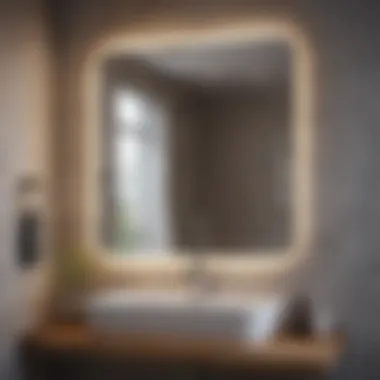
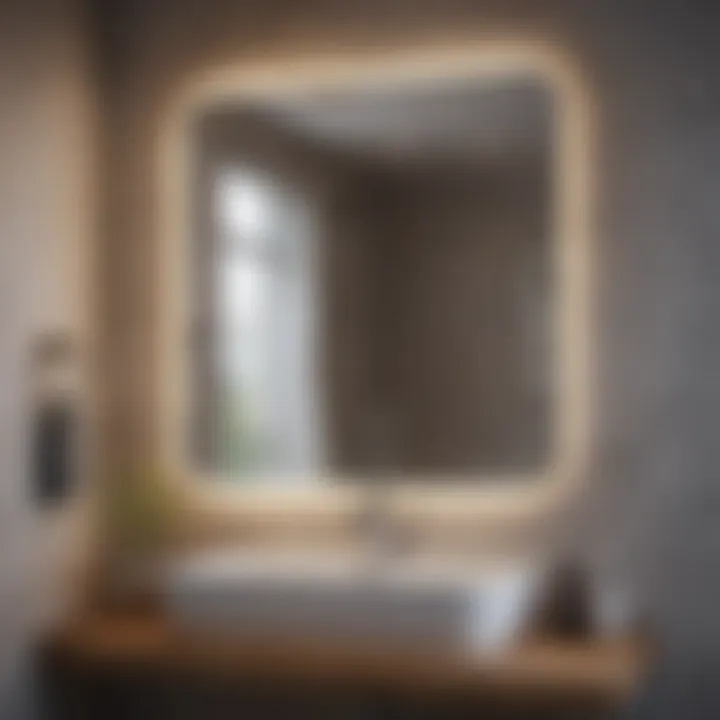
- Ensure compatibility with existing fixtures or opt for complete smart units.
- Look for user-friendly interfaces that the whole family can use.
- Assess installation requirements — some may need professional assistance, while others are DIY-friendly.
Remote Control and Automation
Automation in bathroom lighting adds another layer of convenience that aligns with busy lifestyles. Remote control features extend beyond simple on/off switches, enabling a level of sophistication that resonates with today’s homeowners.
"Imagine stepping into your bathroom and the lights gently brighten to your preferred setting, welcoming you with warmth and clarity."
Features of remote-controlled lighting include:
- Scheduled Lighting: Program times for the lights to turn on or off, aiding in energy conservation and ensuring that you never walk into a dark bathroom again.
- Thematic Settings: Some systems allow you to switch between presets like , , or , instantly adjusting the lighting to your specified needs.
- Integration with Other Devices: Sync your lighting with other smart home systems like security or climate control for a cohesive home environment.
Things to keep in mind:
- Choose systems that allow for future upgrades.
- Ensure the system is straightforward for every family member to navigate.
- Look into the longevity of bulbs to avoid repeated replacements, ensuring your system offers a sensible long-term investment.
By embracing these technological advancements in bathroom lighting, homeowners not only enhance the functionality of their spaces but elevate their overall living experience. The integration of smart solutions and remote capabilities ensures that the bathroom becomes a haven of comfort, innovation, and efficiency.
Safety Considerations in Bathroom Lighting
When it comes to bathroom lighting, especially above mirrors, safety is paramount. The bathroom is a unique space where moisture abounds, and lighting fixtures must be situated appropriately to avoid accidents. Given that bathrooms can be slippery and prone to spills, properly installed and moisture-resistant lighting takes on a crucial role in ensuring the safety of you and your family.
Moisture Resistance of Fixtures
First and foremost, understanding moisture resistance in lighting fixtures is vital. Bathrooms operate in environments that can range from steamy to downright soggy, depending on how often you enjoy those long, hot showers. Fixtures need to be rated for damp or wet locations—meaning they can withstand humidity and the occasional splash of water.
Consider using fixtures with IP ratings, which are indicative of their protective qualities. An IP44 rating offers decent protection from water splashes, while an IP65 or higher is optimal for areas exposed to more moisture, such as near a shower. When selecting fixtures, look for materials like stainless steel or glass, as these are less prone to rust or corrosion.
Proper Electrical Safety Practices
Equally significant are the electrical safety practices that can prevent potential hazards. Electrical wiring in the bathroom must comply with local codes and standards, which are there to mitigate risks linked to moisture. One fundamental principle is ensuring that all electrical installations are performed by a qualified electrician. This is not just about peace of mind; it’s about safeguarding your home and family.
Consider these critical electrical safety tips:
- Use GFCIs (Ground Fault Circuit Interrupters): These devices automatically cut off electricity when they detect a ground fault, minimizing risks of electric shock.
- Consult Local Codes: Make certain that all light fixtures and outlets comply with local electrical codes, as they provide specifications for installation in wet areas.
- Seal Gaps Properly: Any light fixtures that intrude into the wet area should be sealed correctly to prevent moisture from seeping through gaps.
- Avoid Overloading Circuits: Ensure that your bathroom circuits are not overloaded by verifying the wattage of the bulbs being used.
"Safety should never be an afterthought—especially in spaces where electricity and water intersect."
Attention to these safety considerations ensures that your bathroom not only illuminates your space effectively but also keeps you and your loved ones safe from potential hazards. When lighting design prioritizes safety, it not only enhances functionality but also cultivates a sense of security within your home.
Case Studies of Bathroom Lighting Design
Examining case studies pertaining to bathroom lighting design is crucial in understanding the practical applications of theories discussed in this article. These real-world examples offer insights into how strategic lighting can improve functionality while also enhancing the decor of a space. Particularly, when focusing on lighting above mirrors, it becomes apparent how different styles, fixture types, and placements influence not only aesthetics but also the everyday experiences within bathrooms. By analyzing various setups, homeowners can glean inspiration for their own spaces and consider the myriad benefits that come with thoughtful lighting designs.
Some significant elements to consider in these case studies include:
- Functional Efficiency: How various designs serve daily tasks, such as grooming, shaving, or applying makeup.
- Aesthetic Value: The role that lighting plays in establishing a certain ambiance or atmosphere.
- Innovative Techniques: Unique methods used in specific installations to tackle common challenges in bathroom light setup.
Residential Examples
In residential projects, lighting above mirrors often serves as the backbone of the grooming experience. One modern home in Portland serves as a prime example of utilizing warm, dimmable LED fixtures strategically placed above an oversized mirror. This design not only brightens the space effectively but also allows flexibility for different times of day and moods, catering well to the diverse needs of family members. More importantly, it highlights how functionality can coalesce with a pleasing aesthetic.
Moreover, consider a small apartment bathroom in New York City, where space is at a premium. Here, a combination of wall-mounted sconces and recessed lighting provides both illumination and a sense of openness. The strategic placement of lights helps eliminate shadows, creating a more flattering light for personal grooming tasks, while making the small area appear larger than it really is.
Homeowners embraced an open-concept design where mirrors extend from floor to ceiling. This creates an illusion of depth when paired with well-placed lighting, resulting in a space that feels airy and inviting. Such design choices provide lessons on maximizing small areas through intelligent light placement while enhancing overall usability.
Commercial Installations
Commercial installations bring a different set of challenges and goals when it comes to lighting above mirrors. One notable case is a high-end salon in San Francisco, where specific attention was paid to lighting in the areas where clients prepare for styling. Excitingly, a unique triple-band lighting system was implemented, providing balanced lighting that eliminates unflattering shadows and enhances the natural features of clients. It showcases a clear balance of function and ambiance, showcasing just how much the right lighting can affect a client's experience.
Another instructive case revolves around a luxury hotel’s spa bathroom. Here, backlit mirrors combined with recessed lights control both brightness and atmosphere, providing an escape-like feel in a busy urban environment. The combination of these lighting techniques creates a peaceful atmosphere that encourages relaxation and self-care. Enveloping the space with soft light further promotes a sense of tranquility, in turn improving visitor satisfaction, reflecting the significant relationship between lighting design and the overall experience.
By studying these cases, one can appreciate the nuanced considerations each space demands, from real estate constraints to user experiences. Overall, both residential and commercial spaces demonstrate the vital role that effective lighting above mirrors plays in enhancing both functionality and aesthetics in diverse bathroom environments.
"Effective lighting design transforms a bathroom from a simple utility space into a personal haven for relaxation and self-care."
DIY vs. Professional Installation
When considering bathroom mirror lighting, one big question arises: should you tackle the installation yourself or hire a pro? It's not just about light bulbs and fixtures; it's about the overall feel and functionality of your space. Making the right choice can save you stress, time, and even a few bucks.
Assessing Your Skills
Before you decide to roll up your sleeves and get to work, it's crucial to take stock of your skills. Are you comfortable with tools and have some background in basic electrical work? It’s kind of like making sure the car you want to drive has sufficient gas.
- Experience Level: If you’ve put together furniture or fixed up a few things around the house, you may feel confident enough to install lighting above your mirror. However, if you find yourself scratching your head at the thought of wires and circuits, it might be best to step back.
- Understanding of Safety Protocols: Working with electricity can be risky. Knowing how to turn off the power and handle wiring safely is non-negotiable. If you’re not well-versed in these areas, it’s safer to consult with a professional.
- Time Investment: Consider how much time you have available. DIY installations can sometimes turn into projects that stretch out longer than anticipated. If you’re juggling a busy household, you might find that professional help is expedited and less stressful in the long run.
Taking a moment to reflect on these points will help you assess whether you can handle the installation or if it’s time to call in reinforcements.
Cost Considerations
Whether you choose to go the DIY route or to hire a pro can have a significant impact on your wallet. Here are some essential factors to weigh when figuring out costs:
- DIY Material Costs: If you elect to do it yourself, you’ll need to consider the total cost of fixtures, bulbs, and installation materials. More often than not, you’ll find a variety of prices out there, and quality can range significantly.
- Professional Fees: On the flip side, bringing in a professional will incur labor costs, which can vary by location and expertise. Some pros charge hourly, while others offer fixed project rates. Always ask for a quote beforehand so you won’t be caught off-guard.
- Long-Term Value: Sometimes, spending a bit more on a professional means you get a better, safer job done. It can save you from potential disasters down the line. Think of it as paying for peace of mind—this is your bathroom we’re talking about, not just any area of the house.
"Investing in professional installation ensures adherence to safety standards, which can save you from costly electrical accidents in the future."
- Future Repairs: If you go the DIY route and make a mistake, the cost of future repairs can outweigh the initial savings. Keep an eye on the total picture when budgeting your project; sometimes skimping here and there can lead to larger headaches later.
In summary, assessing your skills and carefully weighing the costs of DIY versus professional help will lead you to a more informed decision that aligns with your needs and your budget. Whether you choose to get hands-on or leave it to the experts, proper planning ensures that the lighting above your bathroom mirror is nothing short of perfect.
Future of Bathroom Lighting
The future of bathroom lighting, especially above mirrors, is poised at the intersection of innovation and practicality. As we look ahead, several key elements stand out that promise to transform the way light interacts with our most personal spaces. With advancements in technology and a growing emphasis on design aesthetics, understanding these trends becomes essential for homeowners looking to enhance their bathrooms.
Innovations on the Horizon
We find ourselves in an era where technology plays a pivotal role. Smart lighting solutions are at the forefront, allowing individuals to customize their bathroom lighting experience to fit their needs and preferences. Imagine having the ability to control your mirror lights with a simple voice command or through an app. Features such as color-changing bulbs can create a different atmosphere suited for a relaxing bath or an energizing morning routine.
More manufacturers are incorporating integrated touch controls within mirror designs. This technology not only simplifies usage but also minimizes the number of visible switches, maintaining a sleek look. Lights are becoming increasingly adaptive, with some models featuring built-in sensors that adjust brightness based on the natural light available in the room. This dual-function ability not only enhances aesthetics but also contributes significantly to energy efficiency.
Sustainability Trends
As environmental awareness grows, sustainable lighting solutions are increasingly gaining traction. Energy-efficient LEDs are leading this charge. They consume significantly less energy compared to conventional bulbs, translating to lower electricity bills and a smaller carbon footprint.
Many homeowners are now considering fixtures made from recycled materials or those that are designed for longevity. This shift is not just a trend; it's a thoughtful approach to minimizing waste in a world grappling with excess. Besides, integrating lights that align with sustainable practices can elevate the overall design appeal of a bathroom.
"In the future, bathroom lighting will not only be about illumination but creating an experience that balances energy efficiency and personal ambiance."
Furthermore, the use of daylight simulation bulbs that mimic natural sunlight can improve the psychological well-being of users. They enhance the functionality of mirrors while connecting individuals to nature, even when indoors. This holistic approach fosters a more tranquil bathroom experience, promoting relaxation and reducing stress.















